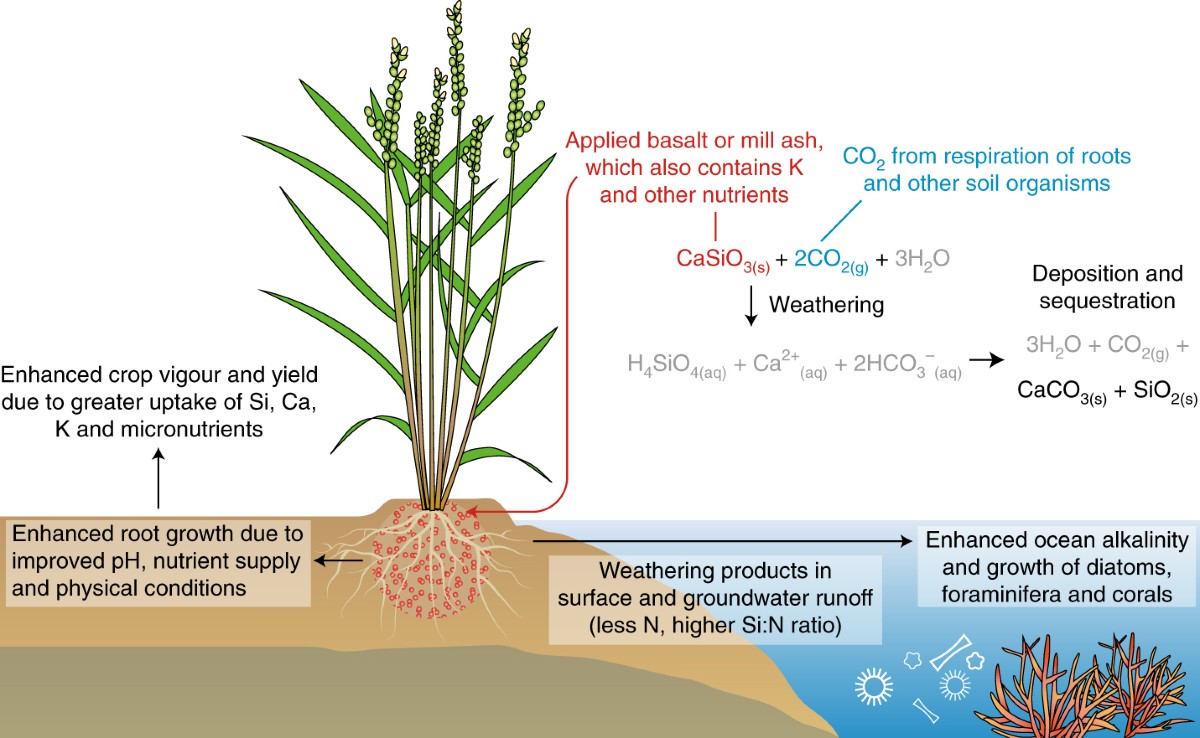
Enhanced weathering (EW) is gaining attention as an effective carbon dioxide removal (CDR) method. Recent research highlights that EW in US agriculture could sequester up to 0.49 GtCO2 annually by 2070, making it a vital tool for achieving net-zero emissions.
The Role of Enhanced Weathering in Carbon Removal
What is Enhanced Weathering?
EW involves applying crushed silicate rocks to farmland, where natural chemical reactions absorb CO2 from the atmosphere. This process enhances soil health while providing long-term carbon sequestration.
Why Agriculture?
US farmlands, particularly in the Corn Belt states like Illinois, Iowa, and Indiana, are ideal for EW. With large agricultural areas and existing infrastructure, these states are poised to lead EW adoption.
>> RELATED: Senate Agriculture Committee Introduces Draft Farm Bill with Key Updates for Bioethanol and Biofuels

Key Findings and Industry Involvement
Carbon Sequestration Potential
EW could sequester 0.16 to 0.30 GtCO2 annually by 2050, rising to 0.49 GtCO2 by 2070. Companies such as Vesta and UNDO are leading EW initiatives, focusing on deploying EW at scale across the US.
Vesta, known for its coastal EW projects, is also exploring agricultural applications by collaborating with farmers to integrate crushed basalt into their soil management practices. Their pilot projects in Florida and California have demonstrated significant carbon capture potential.
UNDO is working with agricultural partners across the Midwest, providing farmers with technical support and basalt supply. Their research emphasizes the dual benefits of EW: carbon removal and improved crop yields.
Cost and Feasibility
By 2050, EW costs are expected to decrease to $100-$150 per ton of CO2, making it a competitive CDR option. Vulcan Materials Company supplies basalt for EW, leveraging its extensive quarrying operations across the US. Heirloom develops technology to efficiently grind and distribute rock dust, partnering with agricultural cooperatives to streamline deployment.
Lithos Carbon, another key player, offers a full-service EW platform for farmers, including basalt application, soil testing, and carbon credit generation. Their partnerships with large farms in Iowa and Nebraska have provided valuable data on EW’s long-term impacts.
>> In Other News: Innovators Gear Up Work on ‘Green’ Hydrogen Plane With Plans for Nonstop 9-day Trip Around Earth
Environmental Benefits
EW not only sequesters carbon but also enhances soil pH, reduces dependence on chemical fertilizers, and lowers ground-level ozone. Planetary Technologies supports these efforts by developing monitoring systems that track EW’s environmental benefits and provide real-time data to stakeholders.
Companies Driving EW Innovation
Remineralize the Earth advocates for global EW adoption, funding research and promoting EW’s benefits through educational campaigns. Lithos Carbon continues to expand its network, recently partnering with The Nature Conservancy to scale EW in the US and ensure sustainable practices.
Challenges and Opportunities
Scaling Up
Expanding EW requires infrastructure investment, policy support, and collaboration with farmers and industries. Lithos Carbon is already collaborating with agricultural cooperatives to bring EW to farmlands, while Carbon Drawdown Collective advocates for policy incentives and public funding to accelerate EW adoption.
Social and Environmental Considerations
EW deployment raises environmental and social concerns, necessitating transparent monitoring and stakeholder engagement. CarbonPlan plays a key role in tracking EW’s environmental impact, ensuring safety and sustainability. Additionally, TerraFixing is developing software tools that help farmers calculate their carbon removal potential and optimize EW applications.
Policy and Research Needs
Federal incentives and research funding are crucial for EW scaling. Initiatives by USDA and DOE aim to support EW through grants, pilot projects, and technical assistance programs.
The Future of EW in US Agriculture
“Transforming US agriculture for carbon removal with enhanced weathering” is essential for meeting climate targets. As noted by researchers, EW is critical for US decarbonization with federal support and investment.
“Public awareness of EW and equity impacts across the USA need further exploration,” highlighting the need for community engagement.
With leading companies like Vesta, Lithos Carbon, Planetary Technologies, Heirloom, and TerraFixing, EW is set to become a cornerstone of US climate and agricultural policy. Their ongoing projects and collaborations promise a sustainable future through carbon removal, improved soil health, and resilient agricultural systems.
Subscribe to the newsletter
Daily decarbonization data and news delivered to your inbox
Follow the money flow of climate, technology, and energy investments to uncover new opportunities and jobs.
Latest issues
-
The CO₂ Pipeline Everyone Said Couldn’t Happen
Inside This Issue 🛠️ Tallgrass Found the CO2 Pipeline Formula Others Missed 🚂 HyOrc & Zeltech Advance Practical Locomotive Retrofit Pathway as U.S. Rail Emissions Face Growing Scrutiny 💰 Secre...
-
How 45Q Credits Revived This Troubled $9B Megaproject
Inside This Issue 💰 How 45Q Credits Revived This Troubled $9B Megaproject 🍁 Commencement of First Phase Operations for a Carbon Capture and Storage (CCS) Project in Canada 🤝 Haffner Energy Secures...
-
The Deal Structure Everyone's About to Copy
Inside This Issue 💼 The Deal Structure Everyone's About to Copy 📈 Exxonmobil Raises Its 2030 Plan – Transformation Delivering Higher Earnings, Stronger Cash Flow, and Greater Returns ⚡ Nextera Wor...
Company Announcements
-
C2X to Deliver 3.6 Million Metric Tons of Carbon Removal to Microsoft Over 12 Years
HOUSTON, TEXAS, December 11, 2025: C2X Ltd. has, through its subsidiary Beaver Lake Renewable Energy LLC (Beaver Lake), signed a long-term agreement with Microsoft for the sale and purchase of high...
-
Sandpiper Chemicals Selects Air Water Gas Solutions as ASU Provider for Its Blue Methanol Facility
Sandpiper Chemicals, LLC is pleased to announce that it has selected Air Water Gas Solutions Inc. as its presumptive industrial gases supplier for its Texas City, TX blue methanol facility. Air Wa...
-
SOUTH SAN FRANCISCO, Calif. — (BUSINESS WIRE) — Ebb, a climate and water technology company, has signed a prepurchase agreement with Google to remove 3,500 tons of CO₂ from the atmosphere. The agre...
-
KBR Awarded Green Ammonia Project by IGNIS in Spain
HOUSTON, Dec. 15, 2025 (GLOBE NEWSWIRE) — KBR, Inc. (NYSE: KBR) announced today that it has been awarded a technology and engineering contract by IGNIS for a new green ammonia facility in A Coruña,...